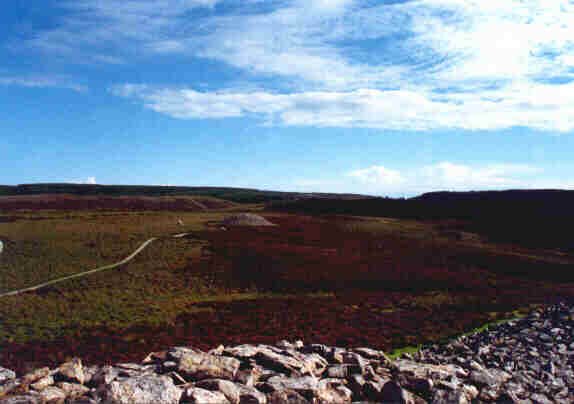|
Monuments and Water: |
| The
Grey Cairns of Camster (Cont.) The Camster Landscape From a landscape perspective, the Camster cairns are sited in relative isolation from the rest of Caithness. Camster Round is located on a fairly flat terrace, while Camster Long occupies a ridge to the NNW. The surrounding landscape is fairly enclosed, with higher ground on all sides, and restricted views. None of the main topographic features of the Caithness landscape are clearly seen from these sites, with only the very top of Spittal Hill visible from the northern forecourt of the long cairn. To the east of the cairns the small Camster Burn flows northwards up its narrow valley, and is visible from both sites. However, slightly to the south of the cairns, but now blocked from view by a modern forestry plantation, is the confluence of several small tributaries which combine to form this burn. Interestingly, this confluence can be regarded as the source of the Wick River, one of the two main watercourses in Caithness. It is this confluence that I now want to explore, as a possible way of understanding the significance and evolution of this monumental landscape. Water is a symbolic natural element that features heavily in many ‘traditional’ cosmologies (Bradley 2000, Richards 1996, Govinda 1992), and is often associated with concepts of birth, regeneration and purification (Richards 1996). Water features, particularly rivers, serve to physically divide and define the landscape, forming boundaries and thresholds (Edmonds 1999a) from and through which the encountered world is perceived. As Richards (1996) points out, the flow of rivers from the source to the sea also provides a potent metaphor for movement, journeys and progression. In the Neolithic, therefore, rivers may have embodied a physical representation of the seasonal routines of movement through the landscape, from which sites such as Camster may have been accorded their significance. |
|
Plate 4 – View from Camster Long
towards Camster Round, |
|
The location of the Camster cairns, and the evidence for earlier activity, gives weight to this argument. As I stated earlier, the cairns are located in relative isolation, with virtually no visual access to other areas of Caithness. This was clearly a deliberate act on the part of the cairn builders, designed perhaps to control and order perceptions of the encountered world. Had the builders chosen to construct their monuments on the terrace directly above and to the west of the actual site the engagements with the landscape and natural elements would have been dramatically different. Here, Loch Camster is located in an area of flat heather moorland, from which there are extensive views over the northern half of Caithness, with views of Warth Hill and Hoy to the north, Spittal Hill, Beinn Freiceadain and Ben Dorrery to the west, and eastwards towards the Hill of Yarrows. By disregarding physical features in the landscape that are prominent in the vistas from many other chambered cairns in Caithness, the builders of the Camster cairns appear to have been relating to a very specific cosmological scheme that revolves around the significance of the Camster Burn. The
discovery of pre-cairn activity dating to the earliest Neolithic on the
ridge below Camster Long points to why the site was chosen for monumental
construction, but, why did that particular location attract activity in
the first place? In practical terms the ridge provides an area of elevated
ground from where there are good views across the surrounding flat
terrace, although there are several other glacial undulations in the
vicinity that would have served this purpose equally well. The ridge on
which the cairn is sited is however, the best place in the landscape to
view the southern end of the burn, and the confluence areas. With
the construction of the chambered cairns, the relationship between the
Neolithic populations and the river is likely to have shifted from an
emphasis on fertility to focus on regeneration and rebirth. As I discussed
earlier, the construction of chambered cairns is thought to have been
associated with the creation of an ancestral ‘whole’. Positioning the
cairns above the source of the Camster Burn, therefore, the Neolithic
populations appear to have been drawing on the ability of water to purify
and transform the human body (Richards 1996), to enable the transition
from individual to ancestor. I suggest this only tentatively, as the
evidence for burial is limited from the Camster cairns, however, I do feel
that such acts may have been more symbolic than physical. |
|
Back to The Grey Cairns of Camster Forward to Conclusion and References |
